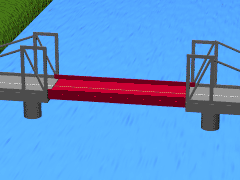Vertical-lift bridge facts for kids
A vertical-lift bridge is a special kind of movable bridge. Imagine a bridge that can lift its middle part straight up! This allows boats to pass underneath easily. The moving part of the bridge stays flat and parallel to the ground as it goes up.
Contents
How Vertical-Lift Bridges Work
Vertical-lift bridges are super cool because they have some great advantages over other moving bridges. Think of bridges that swing open or tilt up. Vertical-lift bridges are often cheaper to build for longer distances. This is because they need less heavy counterweights.
Why They Are Great for Heavy Loads
The counterweights on a vertical-lift bridge only need to be as heavy as the bridge deck itself. Other types, like bascule bridges, need much heavier counterweights. This means vertical-lift bridges can use stronger, heavier materials for their deck. Because of this, they are perfect for carrying heavy things. They are often used for busy railroad tracks.
One Small Challenge
Even with all their benefits, vertical-lift bridges have one main challenge. When the bridge is lifted, the deck stays suspended above the water. This means very tall ships might still have trouble passing underneath. The height of the lifted bridge is limited by how tall its towers are.
Different Ways to Lift a Bridge
Most vertical-lift bridges use tall towers on each side. These towers hold big counterweights that help lift the bridge deck. But some designs are a bit different.
Lifting with Power
Some bridges use powerful hydraulic jacks to lift the deck. These jacks are hidden below the bridge. An example is a 52-foot (16 m) bridge in Milwaukee, USA. You can also learn about table bridges, which are similar.
Using Balance Beams
Another interesting design uses "balance beams" to lift the bridge. These beams are like giant seesaws on top of the lift towers. They help pull the bridge deck up. An example of this type was built in La Salle, Illinois, in the United States.
Cool Examples of Vertical-Lift Bridges
Here are some famous and interesting vertical-lift bridges from around the world.
-
The ASB Bridge in Kansas City, Missouri, USA.
-
The Arthur Kill Vertical Lift Bridge has the longest lift span of any vertical-lift bridge in the world.
-
The Hawthorne Bridge in Portland, Oregon, USA. Built in 1910, it's one of the oldest vertical-lift bridges.
-
The Clarence St. Bridge in Port Colborne, Ontario, Canada.
-
The Guaiba Bridge, which crosses Lake Guaíba, in Porto Alegre, Brazil.
-
A lift bridge over the Erie Canal at Lockport, USA.
-
The Portage Lake Lift Bridge links Houghton, Michigan to Hancock, Michigan, USA.
-
An Sr1 locomotive pulling lumber across a drawbridge north of Kuopio railway station in Finland.
it:Ponte#Ponte sollevabile
See also
 In Spanish: Puente de elevación vertical para niños
In Spanish: Puente de elevación vertical para niños














